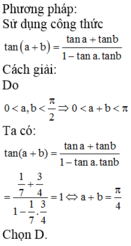

Hãy nhập câu hỏi của bạn vào đây, nếu là tài khoản VIP, bạn sẽ được ưu tiên trả lời.



Lê Huy Hoàng:
a) ĐK: $x\in\mathbb{R}\setminus \left\{k\pi\right\}$ với $k$ nguyên
PT $\Leftrightarrow \tan ^2x-4\tan x+5=0$
$\Leftrightarrow (\tan x-2)^2+1=0$
$\Leftrightarrow (\tan x-2)^2=-1< 0$ (vô lý)
Do đó pt vô nghiệm.
c)
ĐK:.............
PT $\Leftrightarrow 1+\frac{\sin ^2x}{\cos ^2x}-1+\tan x-\sqrt{3}(\tan x+1)=0$
$\Leftrightarrow \tan ^2x+\tan x-\sqrt{3}(\tan x+1)=0$
$\Leftrightarrow \tan ^2x+(1-\sqrt{3})\tan x-\sqrt{3}=0$
$\Rightarrow \tan x=\sqrt{3}$ hoặc $\tan x=-1$
$\Rightarrow x=\pi (k-\frac{1}{4})$ hoặc $x=\pi (k+\frac{1}{3})$ với $k$ nguyên
d)
ĐK:.......
PT $\Leftrightarrow \tan x-\frac{2}{\tan x}+1=0$
$\Leftrightarrow \tan ^2x+\tan x-2=0$
$\Leftrightarrow (\tan x-1)(\tan x+2)=0$
$\Rightarrow \tan x=1$ hoặc $\tan x=-2$
$\Rightarrow x=k\pi +\frac{\pi}{4}$ hoặc $x=k\pi +\tan ^{-2}(-2)$ với $k$ nguyên.

\(cos\left(\frac{x}{2}+15^0\right)=sinx=cos\left(90^0-x\right)\)
\(\Rightarrow\left[{}\begin{matrix}\frac{x}{2}+15^0=90^0-x+k360^0\\\frac{x}{2}+15^0=x-90^0+k360^0\end{matrix}\right.\)
\(\Rightarrow\left[{}\begin{matrix}x=50^0+k240^0\\x=210^0+k720^0\end{matrix}\right.\)
Với \(k=1\Rightarrow x=290^0\)
Bài 2:
\(\Leftrightarrow2sinx+2sinx.cosx-cosx-cos^2x-sin^2x=0\)
\(\Leftrightarrow2sinx+2sinx.cosx-cosx-1=0\)
\(\Leftrightarrow2sinx\left(cosx+1\right)-\left(cosx+1\right)=0\)
\(\Leftrightarrow\left(2sinx-1\right)\left(cosx+1\right)=0\)
\(\Rightarrow\left[{}\begin{matrix}sinx=\frac{1}{2}\\cosx=-1\end{matrix}\right.\) \(\Rightarrow\left[{}\begin{matrix}x=\frac{\pi}{6}+k2\pi\\x=\frac{5\pi}{6}+k2\pi\\x=\pi+k2\pi\end{matrix}\right.\) đáp án B
3/ \(y=\frac{sinx+cosx-1}{sinx-cosx+3}\)
\(\Leftrightarrow y.sinx-y.cosx+3y=sinx+cosx-1\)
\(\Leftrightarrow\left(y-1\right)sinx-\left(y+1\right)cosx=-3y-1\)
Theo điều kiện có nghiệm của pt lượng giác bậc nhất:
\(\left(y-1\right)^2+\left(y+1\right)^2\ge\left(-3y-1\right)^2\)
\(\Leftrightarrow7y^2+6y-1\le0\)
\(\Rightarrow-1\le y\le\frac{1}{7}\Rightarrow y_{max}=\frac{1}{7}\)

a/ \(y'=2cos2x=0\Rightarrow cos2x=0\Rightarrow x=\frac{\pi}{4}+\frac{k\pi}{2}\)
Do \(x\in\left[0;\frac{\pi}{2}\right]\Rightarrow x=\frac{\pi}{4}\)
\(cos2x< 0\) khi \(\frac{\pi}{4}< x< \frac{\pi}{2}\); \(cos2x>0\) khi \(0< x< \frac{\pi}{4}\)
Hàm số đồng biến trên \(\left(0;\frac{\pi}{4}\right)\) nghịch biến trên \(\left(\frac{\pi}{4};\frac{\pi}{2}\right)\)
b/ \(y'=-2sin2x=0\Rightarrow sin2x=0\Rightarrow x=\frac{k\pi}{2}\)
Do \(x\in\left(-\frac{\pi}{4};\frac{\pi}{4}\right)\Rightarrow x=0\)
Hàm số đồng biến trên \(\left(-\frac{\pi}{4};0\right)\) nghịch biến trên \(\left(0;\frac{\pi}{4}\right)\)

Từ giả thiết ta có hệ phương trình : \(\begin{cases}\tan A.\tan B=6\\\tan A.\tan C=3\end{cases}\)
Mặt khác, ta cũng có : \(-\tan B=\tan\left(A+C\right)=\frac{\tan A+\tan C}{1-\tan A.\tan C}=\frac{\tan A+\tan C}{1-3}=-\frac{1}{2}\left(\tan A+\tan C\right)\)
\(\Leftrightarrow2\tan B=\tan A+\tan C\)
\(\Leftrightarrow2\tan A\tan B=1\tan^2A+\tan A.\tan C\)
\(\Leftrightarrow2.6=2\tan^2A+3\)
\(\Leftrightarrow\tan^2A=9\)
Theo giả thiết : \(\tan A\tan B=6>0\)
\(\tan A\tan C=3>0\)
Cho nên \(\tan A>0,\tan B>0,\tan C>0\)
Suy ra \(\tan A=3,\tan B=2,\tan C=1\)
Điều đó chứng tỏ \(\tan A,\tan B,\tan C\) lập thành cấp số cộng có công sai d = 1

a: pi/2<a<pi
=>sin a>0
\(sina=\sqrt{1-\left(-\dfrac{1}{\sqrt{3}}\right)^2}=\dfrac{\sqrt{2}}{\sqrt{3}}\)
\(sin\left(a+\dfrac{pi}{6}\right)=sina\cdot cos\left(\dfrac{pi}{6}\right)+sin\left(\dfrac{pi}{6}\right)\cdot cosa\)
\(=\dfrac{\sqrt{3}}{2}\cdot\dfrac{\sqrt{2}}{\sqrt{3}}+\dfrac{1}{2}\cdot-\dfrac{1}{\sqrt{3}}=\dfrac{\sqrt{6}-2}{2\sqrt{3}}\)
b: \(cos\left(a+\dfrac{pi}{6}\right)=cosa\cdot cos\left(\dfrac{pi}{6}\right)-sina\cdot sin\left(\dfrac{pi}{6}\right)\)
\(=\dfrac{-1}{\sqrt{3}}\cdot\dfrac{\sqrt{3}}{2}-\dfrac{\sqrt{2}}{\sqrt{3}}\cdot\dfrac{1}{2}=\dfrac{-\sqrt{3}-\sqrt{2}}{2\sqrt{3}}\)
c: \(sin\left(a-\dfrac{pi}{3}\right)\)
\(=sina\cdot cos\left(\dfrac{pi}{3}\right)-cosa\cdot sin\left(\dfrac{pi}{3}\right)\)
\(=\dfrac{\sqrt{2}}{\sqrt{3}}\cdot\dfrac{1}{2}+\dfrac{1}{\sqrt{3}}\cdot\dfrac{\sqrt{3}}{2}=\dfrac{\sqrt{2}+\sqrt{3}}{2\sqrt{3}}\)
d: \(cos\left(a-\dfrac{pi}{6}\right)\)
\(=cosa\cdot cos\left(\dfrac{pi}{6}\right)+sina\cdot sin\left(\dfrac{pi}{6}\right)\)
\(=\dfrac{-1}{\sqrt{3}}\cdot\dfrac{\sqrt{3}}{2}+\dfrac{\sqrt{2}}{\sqrt{3}}\cdot\dfrac{1}{2}=\dfrac{-\sqrt{3}+\sqrt{2}}{2\sqrt{3}}\)